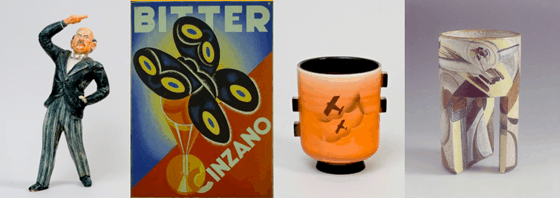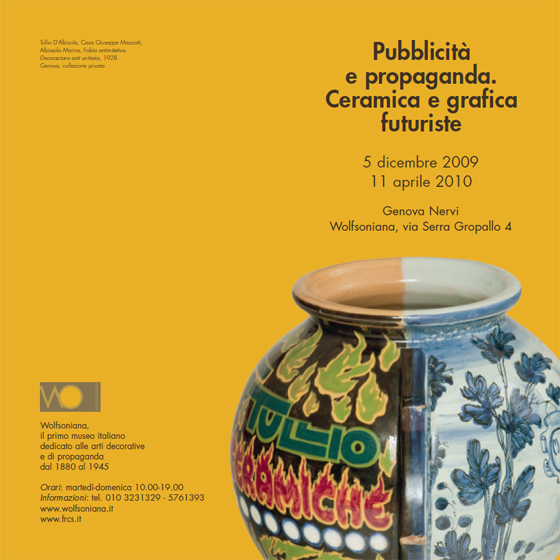The Wolfson Collection


italiano | english
December 5, 2009 - April 11, 2010
The exhibition has been extended to May 2
Exhibition curated by Silvia Barisione, Matteo Fochessati, Gianni Franzone
and Maria Teresa Orengo
Catalogue: Silvana Editoriale
The exhibition – organized by the Wolfsoniana - Fondazione regionale per la
Cultura e lo Spettacolo di Genova (Regional Foundation for Culture and the
Performing Arts of Genoa) and the Regione Liguria (Liguria Region) –
concentrates on the presence of advertising-oriented or political persuasion
in Futurist ceramics and graphics of the twenties and thirties.
Besides documenting the manifold formal experiences that developed in these
fields of research, the exhibition represents a reflection on the expressive
dynamics of that thin line separating advertising -oriented persuasion from
political propaganda, to which the principal exponents of the Futurist
movement adapted the main themes of their poetics. These were the cult of
speed and modernity, of aggressiveness and war, idolatry of the machine and
the ideal of a new, athletic and intrepid man.
Liguria played a leading role in the Futurist ceramics adventure. Although,
admittedly, some examples of Futurist ceramics were created in Faenza in the
second decade of the twentieth century, there was no real production until
the one institutionalized in the Casa Giuseppe Mazzotti of Albissola around
1927. It was headed by the famous Tullio, who signed the manifesto Ceramica
e aeroceramica (Ceramics and Aeroceramics) with F.T. Marinetti in1938.
Alongside the primacy of Albisola, with works by the best-known artists
(Nicolay Diulgheroff, Farfa, Fillia, Tato, Alf Gaudenzi, Giovanni Acquaviva
and Tullio himself), the exhibition also presents experiences which cannot
be defined as Futurist, and yet show tangencies with the creations of
Marinetti’s movement. Some examples are the output of the firm Ceramiche
Rometti of Umbertide or the little-known output of FACI (Fabbrica Artistica
Ceramiche Italiane) of Civita Castellana.
As regards graphics, the exhibition includes names such as Fortunato Depero
and Tullio Crali, besides the artists already mentioned. A number of works
also represent the beginning of the coordinated promotional image for
products and companies on a national level, such as Fernet Branca, Cora,
Campari and Cinzano.
As a collateral event to the exhibition, a significant selection of silverware by Arrigo Finzi (La Spezia 1890 – Milan 1973), which his daughter Olga Finzi Baldi has entrusted on loan to the Wolfsoniana, will be presented. It will be the silver production, countersigned with the trademark “Sant’Elia”, which continued the models designed before the war by the famous Futurist architect Antonio Sant’Elia – with whom Finzi had formed a friendship in 1909 – in an art deco key.

